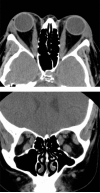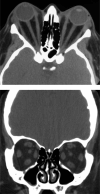Pathogenesis of graves ophthalmopathy: implications for prediction, prevention, and treatment
- PMID: 16815265
- PMCID: PMC3960010
- DOI: 10.1016/j.ajo.2006.02.047
Pathogenesis of graves ophthalmopathy: implications for prediction, prevention, and treatment
Abstract
Purpose: To review current concepts regarding the pathogenesis of Graves ophthalmopathy (GO). We have presented this information in the context of potential target sites for novel disease therapies.
Design: Review of recent literature.
Methods: Synthesis of recent literature.
Results: Enlargement of the extraocular muscle bodies and expansion of the orbital fatty connective tissues is apparent in patients with GO. These changes result from abnormal hyaluronic acid accumulation and edema within these tissues and expanded volume of the orbital adipose tissues. Recent studies have suggested that the increase in orbital fat volume is caused by stimulation of adipogenesis within these tissues. The orbital fibroblast appears to be the major target cell of the autoimmune process in GO. A subset of these cells is capable of producing hyaluronic acid and differentiating into mature adipocytes, given appropriate stimulation. In addition, orbital fibroblasts from patients with GO have been shown to display immunoregulatory molecules and to express both thyrotropin receptors (TSHRs) and insulin-like growth factor 1 receptors (IGF-1Rs). Increased TSHR expression in the GO orbit appears to be the result of stimulated adipocyte differentiation. The activation of IGF-1R on orbital fibroblasts by immunoglobulins from GO patients results in increased production of both hyaluronic acid and molecules that stimulate the infiltration of activated T cells into areas of inflammation.
Conclusions: Potential targets for novel therapeutic agents to be used in GO include blocking T-cell costimulation, depleting B cells, inhibiting cytokine action, targeting the IGF-1R or the TSHR, and preventing connective tissue remodeling.
Figures




References
-
- Bahn RS, Heufelder AE. Pathogenesis of Graves ophthalmopathy. N Engl J Med. 1993;329:1468–1475. - PubMed
-
- Peyster RG, Ginsberg F, Silber JH, Adler LP. Exophthalmos caused by excessive fat: CT volumetric analysis and differential diagnosis. AJR Am J Roentgenol. 1986;146:459–464. - PubMed
-
- Bahn RS. Clinical review 157: pathophysiology of Graves ophthalmopathy: The cycle of disease. J Clin Endocrinol Metab. 2003;88:1939–1946. - PubMed
-
- Smith TJ, Koumas L, Gagnon A, et al. Orbital fibroblast heterogeneity may determine the clinical presentation of thyroid-associated ophthalmopathy. J Clin Endocrinol Metab. 2002;87:385–392. - PubMed
-
- Fatourechi V, Bartley GB, Eghbali-Fatourechi GZ, Powell CC, Ahmed DD, Garrity JA. Graves dermopathy and acropachy are markers of severe Graves ophthalmopathy. Thyroid. 2003;13:1141–1144. - PubMed
Publication types
MeSH terms
Grants and funding
LinkOut - more resources
Full Text Sources

